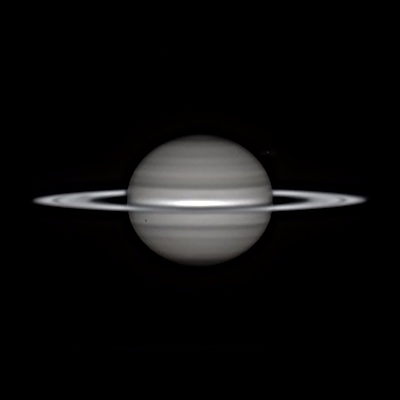This was my 3rd session with Saturn in a week, after no astro for nearly 6 months. I finally feel that I'm getting back into the saddle. Conditions when I started this session were truly awful. I wanted to get done earlier so that I could go to bed at a reasonable time, but that meant Saturn was at only 26° elevation and on reflection (no pun intended), I think the scope was pointing close to where I was sitting, so thermals coming from me didn't help. Once Saturn gained a bit more elevation and the scope moved away from me, the seeing significatly improved, giving me the best that I've experienced this apparition. I ran a couple of 12x2min sequences at 10ms, one each for RGB and IR (742nm). The IR data in particular was much better than previous sessions allowing me to push the processing quite hard to reveal a couple of Saturn's moons, Mimas (or it's nearby shadow) seen in transit as a dark dot below the rings on the left and Rhea as a white dot just off Saturn's disc at 2 o'clock.
IMPORTANT UPDATE:
Following discusion with BAA members, Richard McKim, Martin Lewis and Mike Foulkes and subsequent analysis by Martin and me, I have concluded that the dark spot originally thought to be Mimas, or Mimas's shadow transit, is more probably an artefact introduced by the moon correction tool in WinJupos. Our suspicions were aroused by the lack of any feature in any of the SERs or quality graded, stacked and stretched data, only being seen once the moon correction feature was enabled, together with de-rotation.
After flipping the WinJupos measurement frame for each image 180° and derotating with moon correction, Saturn's moon Rhea is now seen as a streak, but WinJupos still places a dark spot for Mimas in the same location as in the original image which used unflipped data. Additional information and analysis may be seen on my Astrobin page here
I am very grateful to Richard, Martin and Mike for their assistance in reaching this conclusion.


